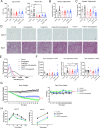Activating Connexin43 gap junctions primes adipose tissue for therapeutic intervention
- PMID: 35865093
- PMCID: PMC9293664
- DOI: 10.1016/j.apsb.2022.02.020
Activating Connexin43 gap junctions primes adipose tissue for therapeutic intervention
Abstract
Adipose tissue is a promising target for treating obesity and metabolic diseases. However, pharmacological agents usually fail to effectively engage adipocytes due to their extraordinarily large size and insufficient vascularization, especially in obese subjects. We have previously shown that during cold exposure, connexin43 (Cx43) gap junctions are induced and activated to connect neighboring adipocytes to share limited sympathetic neuronal input amongst multiple cells. We reason the same mechanism may be leveraged to improve the efficacy of various pharmacological agents that target adipose tissue. Using an adipose tissue-specific Cx43 overexpression mouse model, we demonstrate effectiveness in connecting adipocytes to augment metabolic efficacy of the β 3-adrenergic receptor agonist Mirabegron and FGF21. Additionally, combing those molecules with the Cx43 gap junction channel activator danegaptide shows a similar enhanced efficacy. In light of these findings, we propose a model in which connecting adipocytes via Cx43 gap junction channels primes adipose tissue to pharmacological agents designed to engage it. Thus, Cx43 gap junction activators hold great potential for combination with additional agents targeting adipose tissue.
Keywords: Adipose tissue; Connexin43; FGF21; GJA1; Gap junction; Obesity; Type 2 diabetes; β3-Adrenergic receptor agonist.
© 2022 Chinese Pharmaceutical Association and Institute of Materia Medica, Chinese Academy of Medical Sciences. Production and hosting by Elsevier B.V.
Figures









Similar articles
-
Connexin43 in mesenchymal lineage cells regulates body adiposity and energy metabolism in mice.JCI Insight. 2024 Feb 13;9(6):e170016. doi: 10.1172/jci.insight.170016. JCI Insight. 2024. PMID: 38349739 Free PMC article.
-
Adipocytes in both brown and white adipose tissue of adult mice are functionally connected via gap junctions: implications for Chagas disease.Microbes Infect. 2014 Nov;16(11):893-901. doi: 10.1016/j.micinf.2014.08.006. Epub 2014 Aug 21. Microbes Infect. 2014. PMID: 25150689 Free PMC article.
-
CRTC2 and Nedd4 ligase involvement in FSH and TGFβ1 upregulation of connexin43 gap junction.J Mol Endocrinol. 2015 Dec;55(3):263-75. doi: 10.1530/JME-15-0076. J Mol Endocrinol. 2015. PMID: 26508620
-
New Insights on the Role of Connexins and Gap Junctions Channels in Adipose Tissue and Obesity.Int J Mol Sci. 2021 Nov 10;22(22):12145. doi: 10.3390/ijms222212145. Int J Mol Sci. 2021. PMID: 34830025 Free PMC article. Review.
-
Gap Junction-Dependent and -Independent Functions of Connexin43 in Biology.Biology (Basel). 2022 Feb 11;11(2):283. doi: 10.3390/biology11020283. Biology (Basel). 2022. PMID: 35205149 Free PMC article. Review.
Cited by
-
Importance of the Microenvironment and Mechanosensing in Adipose Tissue Biology.Cells. 2022 Jul 27;11(15):2310. doi: 10.3390/cells11152310. Cells. 2022. PMID: 35954152 Free PMC article. Review.
-
Hyperleptinemia contributes to antipsychotic drug-associated obesity and metabolic disorders.Sci Transl Med. 2023 Nov 22;15(723):eade8460. doi: 10.1126/scitranslmed.ade8460. Epub 2023 Nov 22. Sci Transl Med. 2023. PMID: 37992151 Free PMC article.
-
Maternal Adipocyte Connexin43 Gap Junctions Affect Breastmilk Lactose Levels and Neonate Growth in Mice.Biology (Basel). 2022 Jul 7;11(7):1023. doi: 10.3390/biology11071023. Biology (Basel). 2022. PMID: 36101404 Free PMC article.
-
Connexin43 in mesenchymal lineage cells regulates body adiposity and energy metabolism in mice.bioRxiv [Preprint]. 2024 Jan 7:2024.01.05.574415. doi: 10.1101/2024.01.05.574415. bioRxiv. 2024. Update in: JCI Insight. 2024 Feb 13;9(6):e170016. doi: 10.1172/jci.insight.170016. PMID: 38260624 Free PMC article. Updated. Preprint.
-
Connexin43 in mesenchymal lineage cells regulates body adiposity and energy metabolism in mice.JCI Insight. 2024 Feb 13;9(6):e170016. doi: 10.1172/jci.insight.170016. JCI Insight. 2024. PMID: 38349739 Free PMC article.
References
-
- Khaodhiar L., McCowen K.C., Blackburn G.L. Obesity and its comorbid conditions. Clin Cornerstone. 1999;2:17–31. - PubMed
-
- Gimeno R.E., Moller D.E. FGF21-based pharmacotherapy—potential utility for metabolic disorders. Trends Endocrinol Metabol. 2014;25:303–311. - PubMed
-
- Moller D.E. Metabolic disease drug discovery—"hitting the target" is easier said than done. Cell Metabol. 2012;15:19–24. - PubMed
Grants and funding
LinkOut - more resources
Full Text Sources
Miscellaneous

